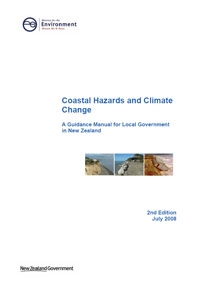Preparing for the effects of climate change in coastal areas

NIWA’s coastal hazards team are creating some practical tools to help planners, engineers, and other professionals involvedin coastal development. Our aim: to ensure the consequences of climate change on our coastline are always factored into coastal development decision making.
Coastal Hazards and Climate Change – A Guidance Manual for Local Government in New Zealand
This manual, recently published by the Ministry for the Environment, was extensively revised and updated by NIWA. The manual focuses primarily on the impacts of sea-level rise, and aims to help local authorities understand the growing long-term risks that climate change will bring to our coastline and its communities. It provides best practice guidance to strengthen land-use planning and resource consent decision making, and recommends a rigorous risk assessment process.
The full manual is available at: www.mfe.govt.nz/publications/climate/coastal-hazardsclimate-change-guidance-manual/ and a summary document will be available in both printed form and online from MfE early in 2009.
Wave and storm-surge projections
Future risk to coastal communities and infrastructure from climate change isn’t just about sea-level rise.Two other coastal processes that will be critical are changes in wave/swell patterns, and increases in sea inundationduring storms (storm tides). There is very little information about how New Zealand might be affected, but a new three-year Foundation for Research, Science and Technology-funded project will change that.
NIWA’s Dr Rob Bell explains: “We aim to create a web-based tool – Wave and Storm Surge Projections (WASP) – which will provide models of wave, swell, and storm surge ‘climates’ around our coastline. Present-day and future climate-change projections will be freely available, and could be used for region-wide risk assessments or to drive local area models that quantify coastal hazards and climate change in a specific location.”
NIWA scientists will work on a Waitemata Harbour case-study, highlighting ways in which the information provided by WASP can be used.
“Overall, the aim is to provide region-specific information but from a nationally consistent WASP facility,” says Rob. “This will result in a more standardised approach by local government and others as they attempt to plan for, and adapt to, the various climate-change impacts on our coastline.”
